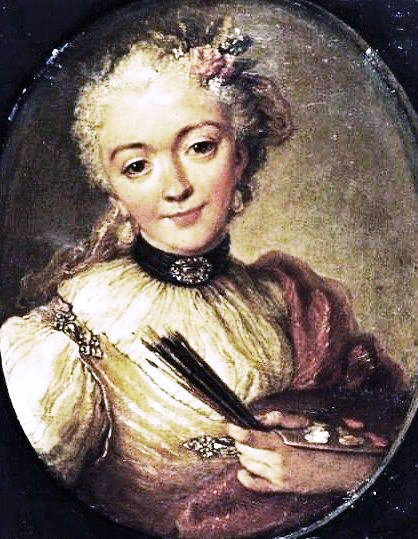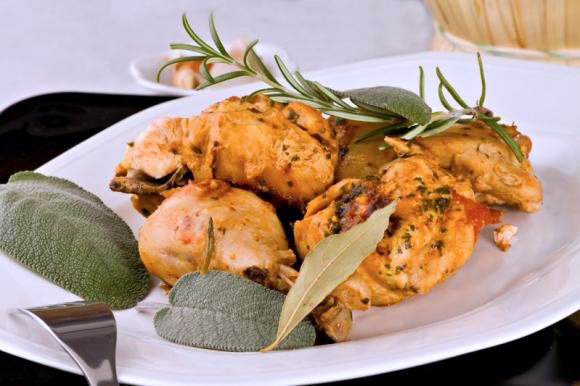In many European countries, the art academies were the arbiters of style. They were also responsible for training artists, exhibiting artwork and promoting the sale of art. In the 18th century, with few exceptions, women were excluded from the academies. Women painters actually had taken a step backward in recognition during early part of the century and biographical information is actually less comprehensive than from women of the previous century. The pinnacle of painting during the period consisted of large-scale compositions, based on historical events; however, none were painted by women, who instead made their names in other genres such as portraiture.
Violante Siries Cerroti
Violante Siries Cerroti was born in Florence in 1709. Her father, Luigi Siries, was a cameo engraver and a director of the prestigious Opificio delle Pietre Dure. She studied under sculptor Filippo della Valle in Florence and also under Giovanna Fratellini. Her art studies took her abroad and in 1726, she worked under Hyacinth Rigaud and François Boucher in Paris. She later traveled to Rome, where she was accepted into Accademia delle’Arte del Didegno in 1732. Returning to Florence, she married Giuseppe Cerroti and continued her artistic studies under Francesco Conti.
Siries was talented in several genres, but established herself as a famous portraitist. She succeeded in gaining the patronage of the Medici family in Florence after the death of Giovanna Fratellini in 1731 and travelled to Rome and Vienna to execute commissions. Her most ambitious work was a fourteen figure family group of the Emperor Charles VI, the father of Maria Theresa (1735). Three of her self-portraits are preserved in the Uffizi Gallery. In later life, Siries became a respected teacher. Her pupils included Anna Bacherini Piattoli and Maria Hadfield Cosway.
Maria Maddalena Gozzi Baldacci
Born in Florence in 1718, daughter of Tommaso Gozzi, Maria Maddalena Gozzi was a pupil of Giovanna Fratellini. She then studied under Giovanni Domenico Campiglia, a painter and engraver who specialized in miniature portraits and pastels. Maria herself specialized in miniatures and primarily worked with pastels. In 1742, Maria married Giuseppe Baldacci. Although very little is known about her life, the abbot Orazio Marrini wrote of her in 1764. He describes her as a prolific artist, who was active in various courts. He referred to a self-portrait from 1737, “I still keep her own portrait of pastels in my collection and I make that distinct esteem that rightfully deserves this virtuous girl.” Although Maria executed many portraits, very few of works remain and those that do are in private collections. She died in Florence in 1782, at the age of 64.
Anna Bacherini Piattoli
Born Anna Bacherini in Florence in 1720, she was a pupil of Florentine painters Francesco Conti and Violante Beatrice Siries, whose work had a profound influence on the student. During this period, she also attracted the attention of the scholar Francesco Niccolò Gabburri, who describes her in his work “Lives of Painters” in 1739.
“This very witty girl lives in Florence under the direction of Cavalier Francesco Conti. Her portrait work is wonderful, astonishing to anyone who sees her paintings. Based on her skills, she was admitted into the Academy of San Luca in Florence. Her technique improves and grows day by day and there is good reason to hope that in a short time, she could be a second Rosalba.” (A reference to Venetian Rococo painter, Rosalba Carriera).
In 1741, Anna Bacherini married Gaetano Piattoli, a portrait painter. Gaetano and Anna had two sons, Giuseppe, who became a painter and Scipione, who became a Catholic priest, educator, writer and political activist.
Anna was a miniaturist, working in oils and pastels. Although it appears that her passion was to paint religious subjects, the realities of earning a living meant that she painted portraits of the wealthy while they wore the popular aristocratic dress of the era. By all accounts, she earned significant income from the endeavor. Among her subjects were the Grand Dukes of Tuscany. Unfortunately, despite a life of hard work and many commissions, little remains of her work today. Furthermore, many of the cataloged works need restoration.
Two religious paintings attributed to Anna Piattoli, “Father Giovanni di Gesù Maria” and “Padre Ildefonso di San Luigi Gonzaga,” are currently preserved in the Uffizi, but have never been exhibited in the Gallery. In the Uffizi warehouse there is also a youthful self-portrait of the painter (oil on canvas), dated 1744 and a “Self-portrait with Gaetano” (c. 1745), in which Anna is represented in the foreground with her husband behind. Her most famous self-portrait, an oil painting of 1776, is on display in the famous Vasari Corridor, which connects the Vecchio Palace with the Pitti Palace. Anna Piattoli Bacherini died in 1788 at the age of 68.
Irene Parenti Duclos
Irene Parenti Duclos was born in Florence in 1754 and was the daughter of Tuscan painter Giuseppe Parenti. It was from her father that she received her early professional training. Her first documented activity was to paint replicas of works in Florence’s Uffizi Gallery, a skill at which she would become renowned. Both male and female artists were permitted to set up their easels in its halls and copy old master paintings and ancient marble statues. Between 1773 and 1793, Irene executed thirty-nine oil copies at the Uffizi, largely in response to the market demand for replicas from society patrons during their Grand Tour. In addition to conventional oil painting, Irene practiced the ancient technique of encaustic painting, a rare skill she had learned while in Bologna in 1784-85. Also known as hot wax painting, it involves using heated beeswax to which colored pigments are added. The liquid is then applied to a surface. Metal tools and special brushes are used to shape the paint before it cools. There are numerous secret recipes used that contain other types of waxes, resins and oils. Her achievements in the field brought her rapid fame and her works commanded high prices.
Irene was member of the art academies of Rome and Bologna, as well as an Accademico Professore in Florence’s Accademia del Disegno since 1783. She was additionally recognized for her poetic talents with an induction into the literary circle of the Accademia degli Arcadi.
Irene’s copy of Andrea del Sarto’s “Madonna del Sacco” in the Galleria dell’Accademia in Florence, is the museum’s only work by a woman artist on permanent display. Completed in 1780, the work is a full-size copy of Andrea del Sarto’s 1525 fresco, which is located in the Chiostro Grande of the Basilica of the Santissima Annunziata. Irene made the work for herself, but in 1781, it was offered for sale to Grand Duke Pietro Leopoldo, through the intervention of Giuseppe Pelli Bencivenni, then director of the Uffizi. The Grand Duke purchased the painting and displayed it in the Pitti Palace, where it hung until 1863.
The work was restored in May 2011 by the Advancing Women Artists Foundation. A simultaneous restoration of del Sarto’s original, sponsored by Friends of Florence, allowed for a thorough comparison between the two works. The restoration was the subject of a documentary film “Irene Parenti Duclos: A Work Restored, An Artist Revealed,” produced by Art Media Studio and based on the book by the same name that was published by the Advancing Women Artists Foundation and The Florentine Press. She died in 1795 in Florence.
Maria Hadfield Cosway
Maria was born in 1760 in Florence, Italy, her father, Charles Hadfield was from England and her mother was Italian. The family were wealthy innkeepers in Livorno and operated three inns in Tuscany, frequented by British aristocrats taking the Grand Tour. One of eight children, Maria demonstrated artistic talent at a young age during her Roman Catholic convent education. Tragedy stuck the family when a mentally unstable nursemaid murdered four of her siblings. Maria, her brothers Richard and George and a younger sister Charlotte survived.
In Florence, Maria studied art under Violante Cerroti and Johann Zoffany. From 1773 to 1778, she copied Old Masters at the Uffizi Gallery. Based upon her work, she was elected to the Academia del Disegno in Florence in 1778. She also went to Rome, where she studied art under Pompeo Batoni. The following year, she and her mother moved to London; her father had passed away three years earlier.
She married celebrated miniature portrait painter Richard Cosway in 1781. It is thought to have been a marriage of convenience. He was 20 years older than and had the reputation as a libertine. Cosway kept her secluded until she fully mastered the English language and forbade his wife from painting. In time, he realized his wife’s talent and helped to develop it further. More than 30 of her works were displayed at the Royal Academy of Art between 1781 until 1801. Richard and Maria had one child together, Louisa Paolina Angelica, but the couple eventually separated and the child died the age of ten.
Maria met Thomas Jefferson in 1786 while the future president was a trade envoy for the new United States. The two shared an interest in art and architecture and together attended exhibits throughout Paris and the countryside. Jefferson developed an attachment to Cosway, spending each day for six weeks with her. It is unclear whether the two engaged in a romantic relationship. Jefferson was a widower and Maria’s husband was unfaithful, but what is known is that they continued to correspond until Jefferson’s death in 1826.
Cosway eventually returned to Italy. The Duke of Lodi invited her to Italy to establish a convent and Catholic school for girls in Lodi, near Milan. In 1821, Maria briefly returned to England to care for her husband before his death. She later returned to Lodi, where she directed the Collegio delle Grazie until her death in 1838.





